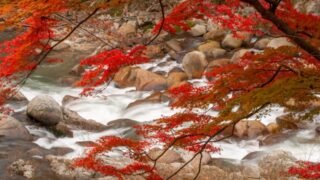5月5日はゴールデンウィーク最後の日、子どもの日です。子どもが元気に成長するのを願う日です。もともとは、男の子のための日です。
May 5 is the last day of Golden Week, Children’s Day. It is a day to wish children to grow up healthy and happy. Originally, this day was for boys.
子どもの日
上の写真は「こいのぼり」です。鯉という魚をデザインしたものです。青い空に黒や赤、青の鯉が泳いでいるようで、とてもきれいですね。鯉は強い魚です。大きな滝も泳いで登っていくことができます。こいのぼりには、この鯉のように強い子どもになってほしいという願いがこめられています。
子どもの日が近づくと、男の子のいる家庭ではこいのぼりを掲げます。
「掲げる」とは、他の人に見えるように高いところに上げるという意味です。「国旗を掲げる」のように使います。また、主張や理想などを人に示す時にも「政策を掲げる」、「理想を掲げる」のように使います。
The photo above is a “Koinobori” (carp streamer). It is a design of a fish called a carp. It looks like black, red, and blue carp swimming in the blue sky. The carp is a strong fish. It can swim and climb up big waterfalls. Koi Noboris (carp streamers) are made with the hope that children will be as strong as these carp.
When Children’s Day comes around, families with boys raise Koinobori.
The word “かかげる” means to raise things high so that others can see it. It is used as “hoisting the national flag. It is also used to express a claim or ideal to others, as in “hoisting a policy” or “hoisting an ideal.”

また上の写真のような、小さい鎧を飾る家もあります。この鎧を五月人形と言います。昔の武士が使っていた鎧のミニチュアです。
鎧の頭の部分を「かぶと」と言います。日本の幼稚園や小学校では、よく折り紙でかぶとを作ります。新聞紙のような大きな紙で作ると、頭にかぶることができます。下の動画では、折り紙のかぶとの作り方を説明しています。意外と簡単に作れるので、作ってみてください。
Some households also display small armor like the one in the photo above. This armor is called “May doll.” It is a miniature of the armor used by samurai in the old days.
The head of the armor is called a kabuto. In Japanese kindergartens and elementary schools, children often make kabuto from origami. If you make it out of a large piece of paper like a newspaper, you can put it on your head. The video below explains how to make an origami kabuto. It is surprisingly easy to make.
食べ物



日本の行事と言えば、食べ物ですね。子どもの日には、多くの家庭で手巻きずしを作ります。手巻きずしは、自分でのりの上に酢飯と刺し身や玉子などをのせて、巻いて食べます。のりの上に酢飯をのせ過ぎると上手く巻けなくなるので、手巻きずしを食べる時は気をつけてくださいね。
上の写真は、前に友だちの家で作った手巻きずしです。とてもおいしくできました。今日も手巻きずしを作る予定です。
Speaking of Japanese events, food is one of them. Many families make temakizushi on Children’s Day. In Temakizushi, you put sushi rice, sashimi, eggs, etc. on top of Nori and roll it up yourself. If you put too much sushi rice on top of the nori, you cannot roll it well, so please be careful when eating temakizushi.
The photo above is a Temakizushi I made at a friend’s house. It turned out delicious. I am planning to make temakizushi again today.

上の写真は子どもの日に食べる和菓子です。右が「ちまき」。左が「かしわもち」です。ちまきは、ささという植物の葉で包んだ、だんごのような甘いお菓子です。かしわもちは、あんこをもちで包んだものです。柏という植物の葉をおもちに巻いています。素朴でおいしい和菓子です。
The photo above shows Japanese sweets eaten on Children’s Day. On the right is “Chimaki”. On the left is “Kashiwa Mochi”. Chimaki is a sweet dumpling-like confection wrapped in the leaves of a plant called Sasa. Kashiwa-mochi is a sweet bean paste wrapped in rice cake. The leaves of the Kashiwa plant are wrapped around the mochi. It is a simple and delicious Japanese confectionery.
また、5月5日には「しょうぶ」という植物をおふろに入れて、おふろに入る習慣があります。しょうぶは、悪いものを寄せ付けないと信じられていました。悪いものから身を守る、昔は本当に大事な考え方だったんですね。
It is also customary to put a plant called “Shobu” in the bathtub on May 5. Shobu was believed to keep bad things away. It was an important idea especially in the old days to protect children from bad things.

今回もここまで読んでくれてありがとうございました。みなさんもおいしいものを食べて、よい週末をお過ごしください。
令和六年五月五日





















